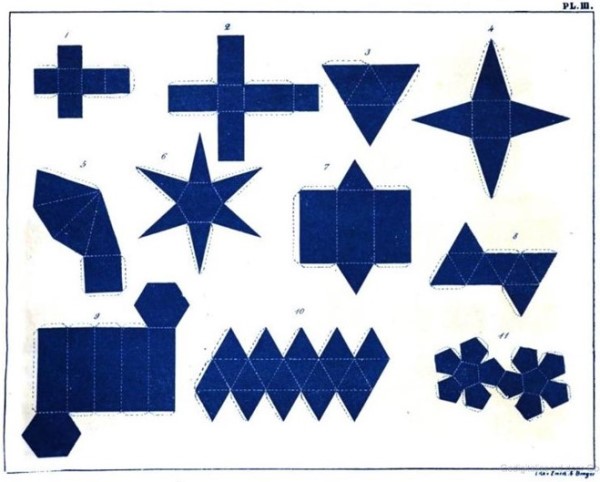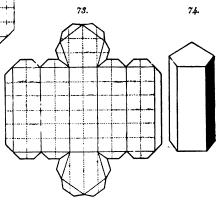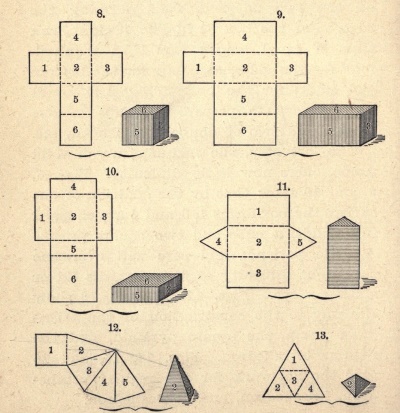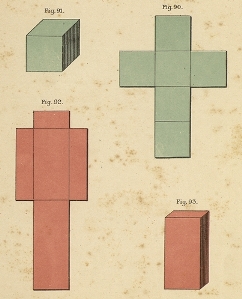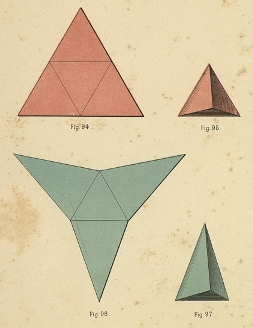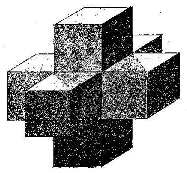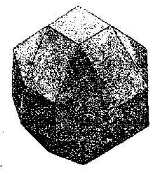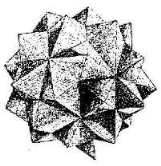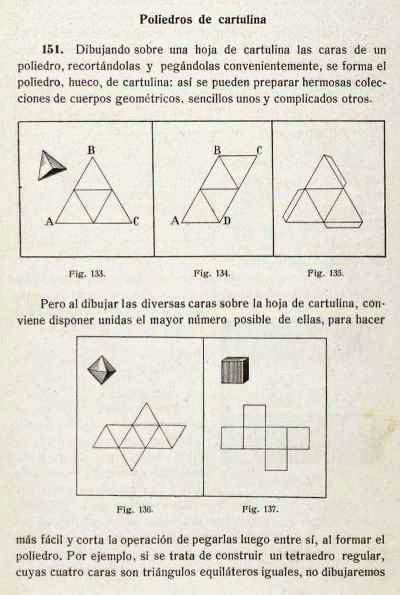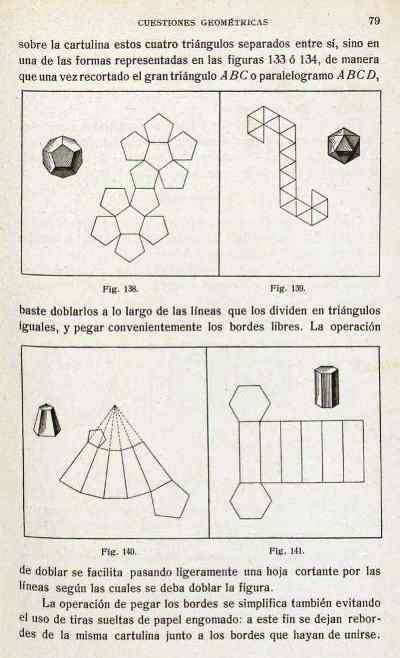| The Public Paperfolding History Project
Last updated 25/11/2025 x |
|||||||
| The Additional Froebelian Occupation of Constructing Polyhedra from Irregular Nets | |||||||
This page is being used to collect information about the history of the Additional Froebelian Occupation of Constructing Polyhedra from Irregular Nets. Please contact me if you know any of this information is incorrect or if you have any other information that should be added. Thank you. This page only collects information about the use of the technique of Constructing Polyhedra from Irregular Nets in an educational setting after the death of Froebel in 1852. Information about the history of this technique at an earlier date and outside an educational context can be found here. Note that this page may be incomplete in regard to early sources at present ********** 1865 'De Fröbelsche kartonwerkers' by Elise Van Calcar, which was published by K H Schadd in Amsterdam in 1863, linked Cardboard Modelling to Froebel but without explaining why. The work contains two plates showing nets for various polyhedra.
*********** 1872 There are several pages of nets for various designs in 'Das Deutschen Knaben Handwerksbusch' by Barth and Niederley, which was published in Bielefield and Leipzig in 1872.
********** 1876 'Die Formenarbeiten Part 6: Die Papparbeiten' (Cardboard Modelling) by Alois Fellner was published by Wien, A. Pichler's Witwe & Sohn during the years 1874/79. The designs fall into three categories, boxes, polyhedra and life forms (in this case buildings). ********** 1880 'Kleiner Kindergarten' by Karl Schellner, which was published by Alfred Holder in Vienna in 1880, contains a section about 'Das Pappen' which says, inter alia, 'This activity is less suitable for children of pre-school age, but more so for pupils in the upper grades of of elementary and middle school, who are not only supposed to make the boxes necessary for the various teaching materials eg seeds, minerals etc, but also, according to the prescribed curriculum, to produce geometric solids from nets they have drawn themselves.'. ********** 1882 Part Two of 'The Kindergarten Guide' by Maria Kraus Boelte and John Kraus, which was probably first published by E. Steiger and Company in New York in 1882, contains nets for what are termed 'Crystals' but are in fact for various prisms and pyramids, all the Platonic solids, a truncated square-based pyramid, a cone and a cylinder.
********** 1887 In 'Primary Methods: A Complete and Methodical Presentation of the Use of Kindergarten Material in the Primary School' by W N Hailmann was published by A S Barnes and Company in New York and Chicago in 1887.
********** In 'Cours de Travail Manuel (Pour les Garcons) - Premiere Partie - Cours Elementaire' by A Planty, which was published by Gedalge Jeune in Paris in 1887.
********** 1895 'Course of Paperfolding' by Eleonore Heerwart, which was published by Charles and Dible in London and Glasgow in 1895, contains a section about constructing polyhedra from irregular nets and suggests that this might 'serve as a transition from paper-folding to cardboard modelling, and from the Kindergarten to the school'.
********** 1903 'La Ensenanza del Trabajo Manuel' by Pedro de Alcántara García and Teodosio Leal y Quiroga, which was published in Madrid in 1903, contains nets, or in some cases partial nets, for creating the tetrahedron, the stellated tetrahedron, the cube, the octahedron, the compound of five tetrahedra, the dodecahedron, the icosahedron, a polyhedron which will wrap the combination of seven cubes, and the three complex compound polyhedra also shown below.
********** 1918 'Ciencia Recreativa' by Jose Estralella, which was published by Gustavo Gili in Barcelona in 1918.
********** 1933 'Diversions and Pastimes' by R M Abraham, which was first published by Constable and Constable in London in 1933, gives nets for the Pyramid (Tetrahedron), Cube, Octahedron, Icosahedron, Dodecahedron, Rhombic Dodecahedron, Tetrahexahedron, Icositetrahedron, Triakisoctahedron, Cube and Octahedron, and Copper Sulphate crystal. ********** 1940 'El Plegado y Cartonaje en la Escuela Primaria' by Antonio M Luchia and Corina Luciani de Luchia, which was published by Editorial Kapelusz in Buenos Aires in 1940 contains a page showing standard polyhedral nets but also shows ways of constructing more complex nets, by paperfolding, which can be assembled without the need for glue.
********** |
|||||||
